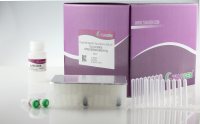Preparation of Next-Generation Sequencing Libraries from Damaged DNA
互联网
589
Next-generation sequencing (NGS) has revolutionized ancient DNA research, especially when combined with high-throughput target enrichment methods. However, attaining high sequencing depth and accuracy from samples often remains problematic due to the damaged state of ancient DNA, in particular the extremely low copy number of ancient DNA and the abundance of uracil residues derived from cytosine deamination that lead to miscoding errors. It is therefore critical to use a highly efficient procedure for conversion of a raw DNA extract into an adaptor-ligated sequencing library, and equally important to reduce errors from uracil residues. We present a protocol for NGS library preparation that allows highly efficient conversion of DNA fragments into an adaptor-ligated form. The protocol incorporates an option to remove the vast majority of uracil miscoding lesions as part of the library preparation process. The procedure requires only two spin column purification steps and no gel purification or bead handling. Starting from an aliquot of DNA extract, a finished, highly amplified library can be generated in 5 h, or under 3 h if uracil removal is not required.






